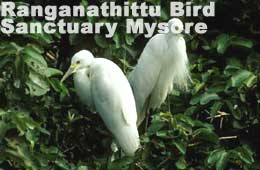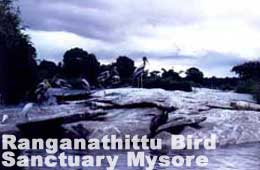|
India Profile takes you on a wildlife tour to the Ranganathittu Bird Sanctuary, situated in the state of Karnataka. Being close to the Mysore city or the adjoining Vrindavan gardens, this bird sanctuary forms an important tourist destination. The bird sanctuary, situated on the banks of the Kaveri River, includes of a group of six islets as well.

The isolated islets and the abundance of aquatic insects during the monsoon make Ranganathittu a favorite abode for birds.
Ranganathittu attained the status of a bird sanctuary in 1940, courtesy of the visions of India. The sanctuary is a paradise for wildlife enthusiasts, nature lovers and bird watchers. The rare species of birds in the sanctuary attract a sizable number of tourists every year.
The peculiarity of this stunningly beautiful sanctuary is the very early commencement of nesting here. The sanctuary is an important Asian nesting and breeding ground for migratory birds from all across the earth. Some species of birds that are known to have made Ranganathittu their breeding abode are spoonbills, open bill storks, darters, white Ibis, little cormorants, egret, heron, partridge, river tern, stone plougher, snake bird, and other exotic bird species that fly to the sanctuary in large flocks.
The authorities have created additional islets at the sanctuary to make way for more number of birds to lay eggs and breed. The birds begin arriving in the sanctuary in December every year. The migratory birds lay eggs and breed until they finally move out of the sanctuary with their little ones in August, only to return yet again the following year. With a boat ride available at the Ranganathittu sanctuary, tourists can take a ride along the river and the islets, where they can witness trees full of beautiful birds of myriad varieties. The Kaveri riverbank also offers excellent spots for picnics.
The picturesque town of Mysore and the garden city of Bangalore are the nearby attractions from the bird sanctuary.
Here you can visit the main nesting area of the Open Billed Starks that is in the middle of the river, where you will find the Terminalia Arjuna tree. This particular Stark, which is the smallest of all the Starks are so named because even after their Bill is closed, one finds a gap in the beak. There are boats arranged to go near the nesting and one can get a close look at the nesting unlike other places where we have to watch with the help of binoculars. Open bill Storks are found here throughout the year, as there is a plentiful supply of food for them in and around the sanctuary. Most of the species of birds that nest in Ranganathittu sanctuary are resident birds and do not move to nay other place in any part of the year. Birds like River Tern, though found in small numbers throughout the year, descend on these sanctuary in thousands during the month of May and later leave the place at the outset of the monsoon.
In the month of June, the weather of the place was hazy but the Egrets looked brilliant and sparkling. It is not easy to differentiate the large Egret from the medium by the size only, but the former has a quite a noticeable kink in its neck which the medium Egret lacks. As we moved along the river, we were fortunate to photograph Night Heron chicks on a small tree. You can see the Spoon Bills, while they develop a thick nuptial crest of white feathers right at the back of the head.
Very interestingly, the trees of Ranganathittu also support a variety of woodland avian fauna such as fruit eaters, bee-eaters and also birds of prey. This unspoiled garden is an enchanting world in shades of green and with a mosaic of reeds and grass. It is so remote and silent that the serenity of its wilderness is often broken with the stately flappings of colorful wings that descend from the sky.
While exploring the park one cab see the River Terns on the rocks in and around the river. These small beautiful birds create a chorus sound peculiar to that time of the year. But there has been a sudden drop in the numbers of these birds mainly due to the change in atmosphere and pollution.
 One can also observe Kingfishers as they dive into the water with speed and accuracy to catch its food. These small beautiful birds have their nest in burroughs dug along the riverbank and so one can only photograph them while they are fishing.
One can also observe Kingfishers as they dive into the water with speed and accuracy to catch its food. These small beautiful birds have their nest in burroughs dug along the riverbank and so one can only photograph them while they are fishing.
The White Ibis is another interesting bird to watch. It has a very primitive black beak curved downwards. They often glide higher on the sky along with the Spoonbills as companions. They assemble in groups. During breeding they nest in groups along with Spoonbills. When once the chicks are hatched, the parent bird rarely leaves the net, leaving only to procure food for the young. There are quite number of eagles and other birds of prey here and the parent Ibis stands guard over the nest all the time to ward off possible intrusion by birds of prey. It is quite interesting to watch the Spoonbill wade into the shallow waters to catch small fish and other insects.
Fact File:
Climate: There are no extremities of temperature at Ranganathittu Sanctuary. The temperature stays between the 23. 29�C range for most parts of the year. In June, when the southwest monsoon peaks throughout Karnataka state, heavy to very heavy rainfall, accompanied by water logging and mild flooding, has been reported from the area.
Getting There: We can provide you all tourist permit car/coach, for the city and intercity drives and can look after all your travel related services. Since the sanctuary is on the Bangalore. Mysore highway, approach is through either of the two cities. The nearest rail junction is Mysore (18 km). The nearest international airport is Bangalore (125 km).
Accommodation: is available at Ranganathittu in the form of three Riverside Cottages. Most tourists, however, prefer to stay at nearby Mysore.
Very near historic Srirangapatnam, along the River Kaveri, are a group of small islands where atop the trees nest countless water birds. Each year, after the onset of the monsoons, ornithologists are attracted to this sanctuary called "Ranganathittu."
|